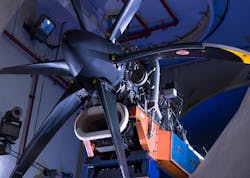Pratt & Whitney Canada Celebrates the 30th Anniversary of the PW100 Turboprop Powerhouse
Pratt & Whitney Canada’s PW100 turboprop family is celebrating the 30th anniversary of its entry into service, marking the beginning of a journey that saw it play a key role in the development of the global regional airline industry thanks to outstanding reliability, durability and operating economics.
“The PW100 is the engine of choice in the regional airline turboprop market and well positioned for continued success in the future,” says Richard Dussault, Vice President, Marketing, P&WC. “It is readily acknowledged that the PW100 helped create the regional turboprop airline market and today it remains the market leader.”
Throughout 2014, P&WC will be commemorating several milestones associated with the PW100 engine family, including its entry into service in December 1984 in Canada on a Dash-8 regional aircraft operated by provincially-owned airline NorOntair. Months later, the PW100 would enter service on the ATR42 of Europe and the Embraer EMB-120 Brasilia of Brazil.
P&WC launched the PW100 family to extend its turboprop-power-range offering from its then current 1,000 shaft horsepower (shp) at the high end of the PT6A family. The PW100 has since grown from 1,800 shp to more than 5,000 shp, incorporating the latest advanced technologies on an ongoing basis to meet changing market conditions and customer needs. In addition to its airline use, the engine series has demonstrated a remarkable suitability for a diverse range of applications and operations, including amphibious aircraft and military transport aircraft.
P&WC has certified 38 PW100 engine models since the 1980s and produced more than 8,000 engines that have logged over 155 million hours in the air. Today, there are over 2,800 PW100-powered regional aircraft in service with more than 500 operators in more than 130 countries.
Last year, P&WC marked the delivery of its 1,000th PW150A engine to Bombardier Aerospace for the popular Q400 aircraft, a milestone that’s indicative of the strong demand for turboprop engines from regional airlines. ATR also marked the delivery of its 1000th aircraft in 2013. Demand for the PW127M engine, powering the ATR 42 and 72 aircraft, continues to be strong with numerous orders in 2013. “Turboprops offer flexibility and efficiency for airline operations, connecting city pairs in traditional and emerging markets that would have never been accessible in the past,” explains Dussault. “The PW100 is ideal for short hauls because of its excellent operating economics, including 30% to 45% less fuel burn and emissions compared to similar-sized regional jets.”
P&WC is currently investing in technology for the next-generation regional turboprop (NGRT), which will offer 20% better fuel burn and 30% lower maintenance costs, with the efficiency and flexibility of a fully integrated propulsion system. It has launched a detailed design of an all-new NGRT and begun testing of the compressor as part of a technology demonstrator program. “The NGRT will deliver in the range of 5,000 to 7,000 shp as well as economic and environmental benefits that will sustain the regional turboprop’s competitive advantage for airlines serving short-haul, high frequency routes,” says Dussault, adding that P&WC expects airline interest to centre on larger aircraft with 90 seats or more.
Follow P&WC:
www.pwc.ca/raa2014
